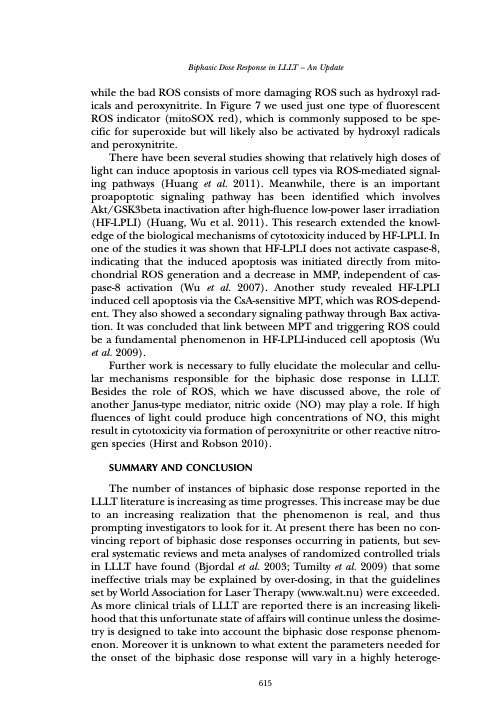
PDF Publication Title:
Text from PDF Page: 014
Biphasic Dose Response in LLLT – An Update while the bad ROS consists of more damaging ROS such as hydroxyl rad- icals and peroxynitrite. In Figure 7 we used just one type of fluorescent ROS indicator (mitoSOX red), which is commonly supposed to be spe- cific for superoxide but will likely also be activated by hydroxyl radicals and peroxynitrite. There have been several studies showing that relatively high doses of light can induce apoptosis in various cell types via ROS-mediated signal- ing pathways (Huang et al. 2011). Meanwhile, there is an important proapoptotic signaling pathway has been identified which involves Akt/GSK3beta inactivation after high-fluence low-power laser irradiation (HF-LPLI) (Huang, Wu et al. 2011). This research extended the knowl- edge of the biological mechanisms of cytotoxicity induced by HF-LPLI. In one of the studies it was shown that HF-LPLI does not activate caspase-8, indicating that the induced apoptosis was initiated directly from mito- chondrial ROS generation and a decrease in MMP, independent of cas- pase-8 activation (Wu et al. 2007). Another study revealed HF-LPLI induced cell apoptosis via the CsA-sensitive MPT, which was ROS-depend- ent. They also showed a secondary signaling pathway through Bax activa- tion. It was concluded that link between MPT and triggering ROS could be a fundamental phenomenon in HF-LPLI-induced cell apoptosis (Wu et al. 2009). Further work is necessary to fully elucidate the molecular and cellu- lar mechanisms responsible for the biphasic dose response in LLLT. Besides the role of ROS, which we have discussed above, the role of another Janus-type mediator, nitric oxide (NO) may play a role. If high fluences of light could produce high concentrations of NO, this might result in cytotoxicity via formation of peroxynitrite or other reactive nitro- gen species (Hirst and Robson 2010). SUMMARY AND CONCLUSION The number of instances of biphasic dose response reported in the LLLT literature is increasing as time progresses. This increase may be due to an increasing realization that the phenomenon is real, and thus prompting investigators to look for it. At present there has been no con- vincing report of biphasic dose responses occurring in patients, but sev- eral systematic reviews and meta analyses of randomized controlled trials in LLLT have found (Bjordal et al. 2003; Tumilty et al. 2009) that some ineffective trials may be explained by over-dosing, in that the guidelines set by World Association for Laser Therapy (www.walt.nu) were exceeded. As more clinical trials of LLLT are reported there is an increasing likeli- hood that this unfortunate state of affairs will continue unless the dosime- try is designed to take into account the biphasic dose response phenom- enon. Moreover it is unknown to what extent the parameters needed for the onset of the biphasic dose response will vary in a highly heteroge- 615PDF Image | BIPHASIC DOSE RESPONSE IN LOW LEVEL LIGHT THERAPY AN UPDATE

PDF Search Title:
BIPHASIC DOSE RESPONSE IN LOW LEVEL LIGHT THERAPY AN UPDATEOriginal File Name Searched:
biphasic-dose-response-low-level-light-therapy.pdfDIY PDF Search: Google It | Yahoo | Bing
Cruise Ship Reviews | Luxury Resort | Jet | Yacht | and Travel Tech More Info
Cruising Review Topics and Articles More Info
Software based on Filemaker for the travel industry More Info
The Burgenstock Resort: Reviews on CruisingReview website... More Info
Resort Reviews: World Class resorts... More Info
The Riffelalp Resort: Reviews on CruisingReview website... More Info
| CONTACT TEL: 608-238-6001 Email: greg@cruisingreview.com | RSS | AMP |